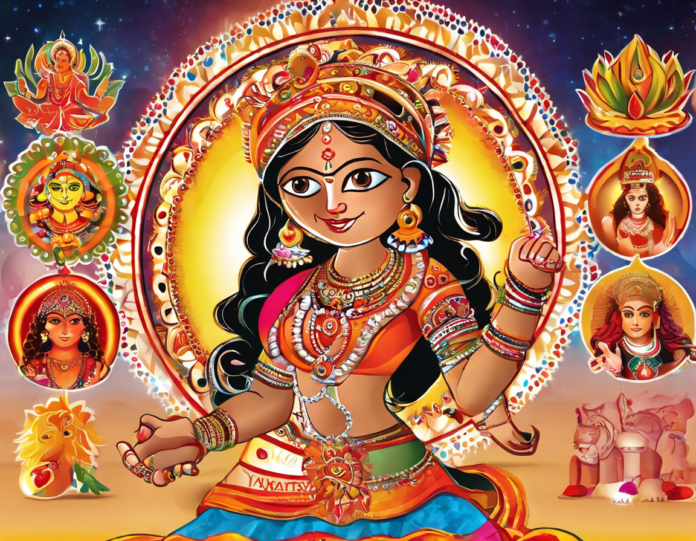What is Navratri?
Navratri is a Hindu festival that spans nine nights and is celebrated every year in autumn. The word "Navratri" is derived from two Sanskrit words: "nava" means nine, and "ratri" means night. The festival is dedicated to the worship of the Hindu goddess Durga and her various forms. Navratri typically falls in the Hindu calendar months of Ashwin or Chaitra, corresponding to September-October and March-April respectively.
Navratri Dates for 2023
In 2023, Navratri will be celebrated from Thursday, 12th October to Friday, 20th October. These dates may vary slightly based on the lunar calendar and the specific traditions followed by different regions or communities.
Navratri Celebrations
Navratri is a vibrant and joyous festival that is celebrated with great fervor across India and in various parts of the world. The festival involves fasting, prayer, dance, and music. In different regions of India, Navratri is celebrated in unique ways with different rituals and traditions.
Significance of Navratri
Navratri holds immense significance in Hindu mythology and is believed to commemorate the victory of goddess Durga over the buffalo demon Mahishasura, symbolizing the victory of good over evil. Each day of Navratri is associated with the worship of different forms of Durga, including Shailaputri, Brahmacharini, Chandraghanta, Kushmanda, Skandamata, Katyayani, Kalratri, Mahagauri, and Siddhidatri.
Navratri Rituals
During Navratri, devotees observe fasts, perform aarti (prayer rituals), and participate in Garba and Dandiya Raas (traditional dances) in honor of the goddess Durga. Some people also set up 'Golu' or display dolls and figurines depicting various themes from Hindu mythology. It is a time of spiritual reflection, community bonding, and cultural celebrations.
Navratri Food
Fasting plays a significant role during Navratri, and people abstain from consuming grains, non-vegetarian food, onion, garlic, and alcohol. Instead, they opt for saatvik (pure) foods like fruits, nuts, dairy products, and specific grains like buckwheat and water chestnut flour. Special dishes like Sabudana Khichdi, Kuttu Ki Puri, and Singhara Atta Halwa are prepared during this festival.
Navratri Colors
Each day of Navratri is associated with a specific color that devotees wear while participating in the festivities. The colors for each day are coordinated as follows: Grey on the first day, Orange on the second day, White on the third day, Red on the fourth day, Royal Blue on the fifth day, Yellow on the sixth day, Green on the seventh day, Peacock Green on the eighth day, and Purple on the ninth day.
Navratri in Different Regions
Navratri is celebrated with various regional customs and traditions across India. In Gujarat, Garba and Dandiya Raas are popular, while in West Bengal, it is celebrated as Durga Puja with elaborate pandal decorations. In Punjab, people organize Jagrans (all-night singing of devotional songs), and in Maharashtra, people display and exchange Apta leaves as a symbol of gold.
Tips for Celebrating Navratri
- Planning: Plan your outfits and colors in advance for each day of Navratri.
- Fasting: If observing a fast, ensure you have all the necessary ingredients for saatvik meals.
- Music and Dance: Participate in Garba or Dandiya events for a fun-filled celebration.
- Community Participation: Join local puja pandals or events for a sense of community and inclusivity.
- Spiritual Reflection: Take time for prayer and meditation to imbibe the spiritual essence of Navratri.
FAQs (Frequently Asked Questions)
1. What is the significance of fasting during Navratri?
Fasting during Navratri is believed to cleanse the body and soul, increase focus and concentration, and invoke the blessings of the goddess Durga. It is a way of practicing self-discipline and devotion.
2. Can non-Hindus participate in Navratri celebrations?
Yes, Navratri celebrations are inclusive, and people from all communities are welcome to join in the festivities. It is an excellent opportunity to experience the rich cultural heritage of India.
3. Are there any specific prayers or mantras recited during Navratri?
Devotees often recite the Durga Chalisa, the Devi Mahatmyam, or other mantras dedicated to the goddess Durga during Navratri. These prayers are believed to invoke divine blessings and protection.
4. What is the significance of Garba and Dandiya Raas during Navratri?
Garba and Dandiya Raas are traditional Gujarati folk dances performed during Navratri to honor the goddess Durga. These energetic and colorful dance forms symbolize the celebration of life and the triumph of good over evil.
5. How can one decorate their home for Navratri?
Homes can be decorated with flowers, rangoli (colorful patterns made from powdered colors), diyas (earthen lamps), and idols or pictures of goddess Durga. Torans (door hangings) made from mango leaves or flowers are also common decorations.
6. What is the significance of the different colors worn during Navratri?
Each color worn during Navratri is associated with a specific day and symbolizes different aspects of the goddess Durga. Wearing these colors is believed to attract positive energy and blessings during the festival.
7. Are there any specific taboos or restrictions during Navratri?
During Navratri, people typically avoid consuming alcohol, non-vegetarian food, onion, garlic, and certain grains. It is also considered inauspicious to cut nails or hair during this period.
8. How is Navratri celebrated in different parts of India?
Navratri celebrations vary across India. In Gujarat, it is marked by Garba dances, while West Bengal celebrates Durga Puja with grand processions and idol immersions. In North India, Ramlila performances are popular during this festival.
9. What is the significance of the goddess Durga's different forms worshipped during Navratri?
Each form of goddess Durga worshipped during Navratri represents a different aspect of feminine power and energy. Devotees seek blessings for strength, wisdom, protection, and prosperity from each form of the goddess.
10. How can one participate in Navratri celebrations if they are unable to attend community events?
One can still celebrate Navratri at home by setting up a small puja area, performing daily prayers, observing fasts, wearing the designated colors, and listening to devotional songs. Online streaming services also offer virtual participation in Navratri events.

